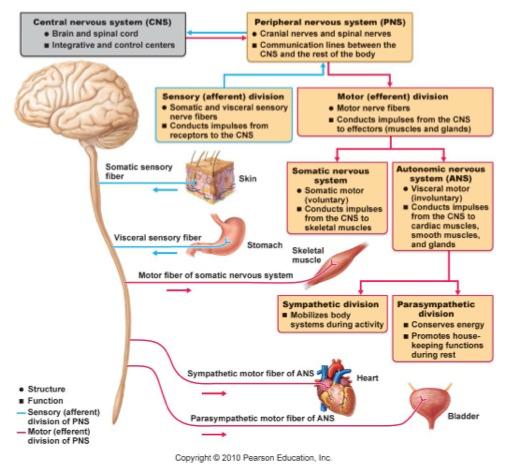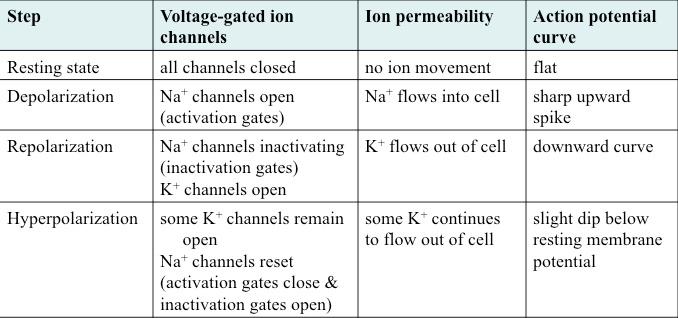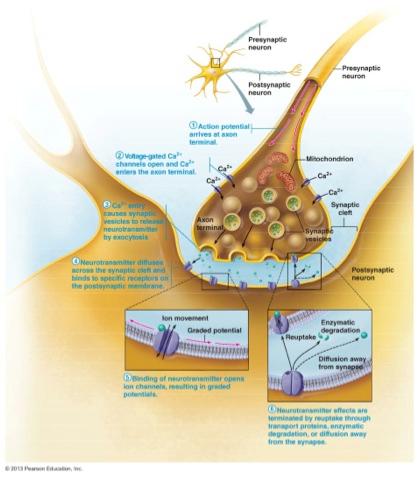Differentiate between the central nervous system and peripheral nervous system.
a. central nervous system (CNS) - brain & spinal cord
i. integration & command center
ii. interprets sensory input & dictates motor responses
b. peripheral nervous system (PNS) - part of nervous system outside CNS; primarily paired cranial & spinal nerves
i. nerves - bundles of axons that extend from the brain & spinal cord
ii. cranial nerves - carry impulses to & from the brain
iii. spinal nerves - carry impulses to & from the spinal cord
Explain the levels of organization in the nervous system (Figure 11.2, page 388).

Name the two principal cell types in nerve tissue.
a. neurons - excitable nerve cells that transmit electrical signals
b. neuroglia - supporting cells that surround & wrap neurons
i. do not carry electrical signals
Describe the structure, location (CNS or PNS), and function of neuroglia (glial cells) – astrocytes, microglial cells, ependymal cells, oligodendrocytes, satellite cells, and Schwann cells (Figure 11.3, page 389).
picture
List the three special characteristics of neurons.
a. extreme longevity - over 100 years with good nutrition
b. amitotic - most neurons don’t divide and can’t be replaced
i. as neurons form a communicating network with other neurons, they lose their ability to divide
c. exception - olfactory epithelium & hippocampus
i. exceptionally high metabolic rate
ii. require continuous supplies of oxygen & glucose
iii. cannot survive more than a few minutes without oxygen
Define the terms perikaryon (soma), chromatophilic substance (Nissl bodies), nucleus, ganglion, tract, nerve, dendrite, and axon.
a. (perikaryon, soma) - consists of a spherical nucleus with a conspicuous nucleolus surrounded by cytoplasm
b. chromatophilic substance (Nissl bodies) - most active & best developed rough endoplasmic reticulum in the body
c. nuclei - clusters of cell bodies win the CNS; most common
d. ganglia - clusters of cell bodies along the nerves in the PNS
e. tracts - bundles of neuron processes in the CNS
f. nerves - bundles of neuron processes in the PNS
Describe the structure and function of a dendrite.
a. Dendrites - short, tapering, diffusely branching processes
i. main receptive or input regions of neuron
ii. dendritic spines - points of close contact (synapses) with other neurons
iii. move incoming signals towards the cell body using short-distance signals called graded potentials (not action potentials)
Describe the structure and function of an axon.
a. Axon - slender process extending from neuron
i. each neuron has a single axon
ii. nerve fibers - long axons
iii. axon collaterals - occasional axon branches, if present
iv. axon hillock - cone-shaped area of neuron where axon arises
v. terminal branches - profuse branches at axon’s end; 10.000+
vi. axon terminal (terminal boutons) - knoblike distal endings of the terminal branches
Contrast anterograde movement and retrograde movement.
a. anterograde movement - toward axon terminal
i. mitochondria, cytoskeletal elements, plasma membrane components, enzymes
b. retrograde movement - away from axon terminal
i. mostly organelles for removal or recycling
Describe the structure and function of myelin sheaths.
a. Myelin sheath - whitish, fatty (protein-lipoid), segmented covering around most long or large axons
i. myelinated fibers - axons with a myelin sheath
ii. longer or larger axons
iii. unmyelinated fibers - without a sheath
iv. dendrites & smaller axons
Define the terms outer collar of perinuclear cytoplasm, myelin sheath gaps (nodes of Ranvier), myelinated, and nonmyelinated.
a. Outer collar of perinuclear cytoplasm - portion of Schwann cell which includes nucleus, cytoplasm, & exposed part of plasma membrane
b. Myelin sheath gaps (Nodes of Ranvier) - gaps in myelin sheath that occur between adjacent Schwann cells
c. Nonmyelinated axons - Schwann cells surround 15 or more thin axons but don’t coil
Contrast the processes used by Schwann cells and oligodendrocytes to form myelin sheaths.
a. Myelin sheath gaps (Nodes of Ranvier) - gaps in myelin sheath that occur between adjacent Schwann cells
-occur at regular intervals (1 mm apart) along myelinated axon
-sites where axon collaterals can emerge
b. Unmyelinated axons - Schwann cells surround 15 or more thin axons but don’t coil
a. CNS myelin sheaths
CNS has both myelinated and unmyelinated axons
b. oligodendrocytes - form myelin sheaths in CNS
have multiple flat processes that can coil around as many as 60 axons at once
c. CNS myelin sheaths - lack an outer collar of perinuclear cytoplasm
Contrast white matter and gray matter.
a. white matter - regions with dense collections of myelinated fibers; primarily fiber tracts
b. gray matter - contains mostly nerve cell bodies & nonmyelinated fibers
Explain the structural classification of neurons (Table 11.1, page 394).
multipolar neurons - three or more processes
one axon and the multiple dendrites
most common type of human neuron (99%)
bipolar neurons - two processes
one axon & one dendrite on opposite sides
rare neurons in some special sense organs
unipolar neurons - single, short process that emerges from cell body & divides T-like into proximal & distal branches
peripheral process - distal;associated with sensory receptor
central process - proximal; enters CNS
found mainly in ganglia in PNS; sensory neurons
Explain the functional classification of neurons (Table 11.1, page 395).
?
Define the terms voltage, potential difference, current, resistance, insulator, conductor, and Ohm’s law.
a. voltage (V) - measure of potential energy generated by separated charge
b. AP’s are measured in millivolts = 0.001 V
c. potential difference (potential) - voltage measured between two points (a-b)
d. current (I) - flow of electrical charge between two points
e. resistance (R) - a substance’s hindrance to charge flow
f. insulator - substance with high electrical resistance
g. conductor - substance with low electrical resistance
h. Ohm’s law - relationship between voltage, current, & resistance
Describe the three types of ion channels.
a. leakage (nongated) channels - channels that are always open
b. gated channels - part of the protein forms a molecular “gate” that changes shape to open and close the channel in response to specific signals
c. Chemically gated (ligand-gated) channels - open when the appropriate chemical binds (in this case, neurotransmitter)
Define and describe resting membrane potential.
a. Resting membrane potential - potential difference across the plasma membrane of a resting neuron
Define the terms graded potential, action potential, depolarization, and hyperpolarization.
a. Graded potential - short-lived, localized change in membrane potential; depolarization or hyperpolarization
b. Depolarization - a small patch of membrane becomes depolarized by a stimulus
c. Action potential (nerve impulse) - a brief reversal of membrane potential with a total amplitude (change in voltage) of about 100 mV (from -70 mV to +30 mV)
d. Hyperpolarization: some K+ channels remain open & Na+ channels reset
Describe the spread and decay of graded potentials.
a. Depolarization spreads - opposite charges attract each other
-local currents depolarize adjacent membrane areas, spreading the wave of depolarization
b. Membrane potential decays with distance - current is lost through “leaky” plasma membrane (leakage channels) causing the voltage to decline with distance from the stimulus; no propagation
-short distance signals
Order the steps in action potential generation (Figure 11.11, page 402).

Describe the action potential curve (Figure 11.11, page 402).
LOOK ON PAGE
Explain how the CNS determines whether a stimulus is strong or weak.
a. frequency of action potentials - the number of impulses per second codes for stimulus intensity
b. strong stimuli - produce more frequent action potentials
c. weak stimuli - produce less frequent action potentials
Differentiate between absolute refractory period and relative refractory period.
a. Absolute refractory period - time from opening of Na+ activation gates until closing of Na+ inactivation gates
b. Relative refractory period - interval following absolute refractory period
List the two factors affecting conduction velocity.
a. degree of myelination - a myelin sheath increases rate of AP propagation
b. axon diameter - the larger the axon’s diameter, the faster it conducts impulses
Define the term synapse.
a. Synapse - a junction that mediates information transfer from one neuron to the next neuron or from a neuron to an effector cell
Identify types of synapses based on structural connections, information flow, and type of stimulus.
a. Types of synapses - based on structural connections
-common types
axodendritic - between axon endings of one neuron & dendrites of other neurons
axosomatic - between axon endings of one neuron & cell bodies (soma) of other neurons
-less common types
axoaxonal - axon to axon
dendrodendritic - dendrite to dendrite
somatodendritic - dendrites to soma
b. Types of neurons - based on information flow
-presynaptic neuron - conducts impulses toward synapse
information sender
-postsynaptic neuron - transmits impulses away from synapse
information receiver
outside of CNS, the postsynaptic cell may be a neuron or an effector cell (muscle cell or gland cell)
inside CNS, the postsynaptic cell is another neuron
-most neurons function as both sender & receiver
-neurons have 1000 to 10,000 axon terminals making synapses & are stimulated by an equal number of other neurons
c.Types of synapses - based on type of stimulus
-electrical synapses - specialized to allow the flow of ions between neurons; less common type
neurons are connected by gap junctions
ions & small molecules can flow from one neuron to the next
neurons joined this way are electrically coupled
rapidly synchronize activity of connected neurons
found in parts of the brain involved in emotions & memory
-chemical synapses - specialized for release & reception of neurotransmitters
parts of chemical synapse
axon terminal of presynaptic neuron - contains synaptic vesicles; each vesicle contains 1000s of neurotransmitter molecules receptor region of postsynaptic neuron -region on the membrane of dendrite or cell body
Define the terms synaptic cleft and synaptic delay.
a. Synaptic cleft - fluid-filled space separating presynaptic & postsynaptic membranes
b. Synaptic delay - time needed for neurotransmitter’s release, diffusion across synaptic cleft, & binding to receptors
Order the steps in information transfer across chemical synapses (Figure 11.17, page 409).

Differentiate between an excitatory synapse and an inhibitory synapse.
a. Excitatory synapse - neurotransmitter binding causes depolarization of postsynaptic membrane
b. Inhibitory synapse - neurotransmitter binding causes hyperpolarization of postsynaptic membrane
Explain the chemical classes of neurotransmitters. Place a specific neurotransmitter in its chemical class (only responsible for neurotransmitters mentioned in lecture).
slides 17-19 on chapter 11 part 4
Differentiate between excitatory and inhibitory neurotransmitters. Differentiate between direct and indirect actions of neurotransmitters.
a. direct - neurotransmitters that bind to & open ion channels
i. promote rapid responses (channel-linked receptors)
ii. examples - acetylcholine, amino acids
b. indirect - neurotransmitters that act through second messengers
i. promote long-lasting effects (G protein-linked receptors)
ii. examples - biogenic amines, peptides, dissolved gases